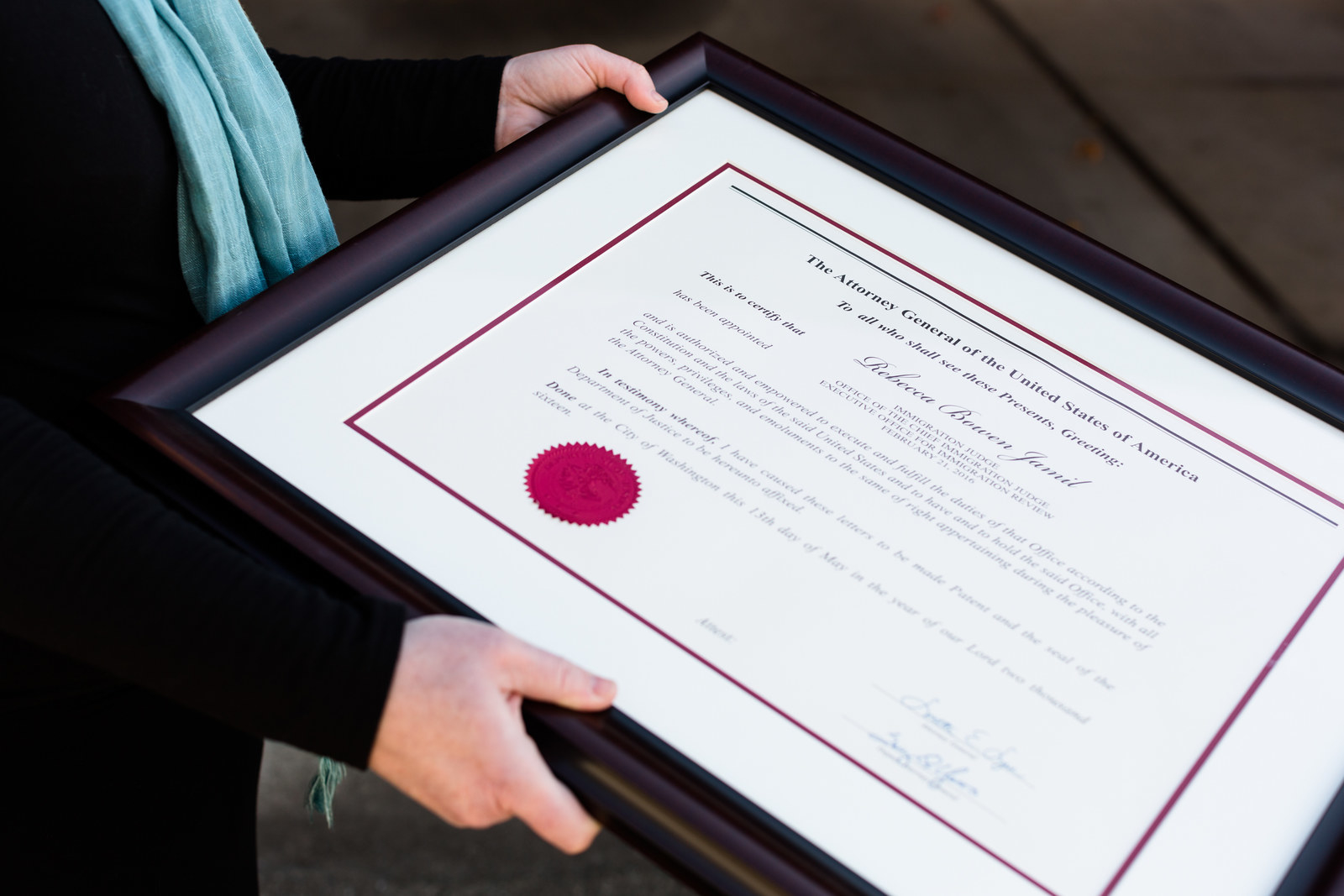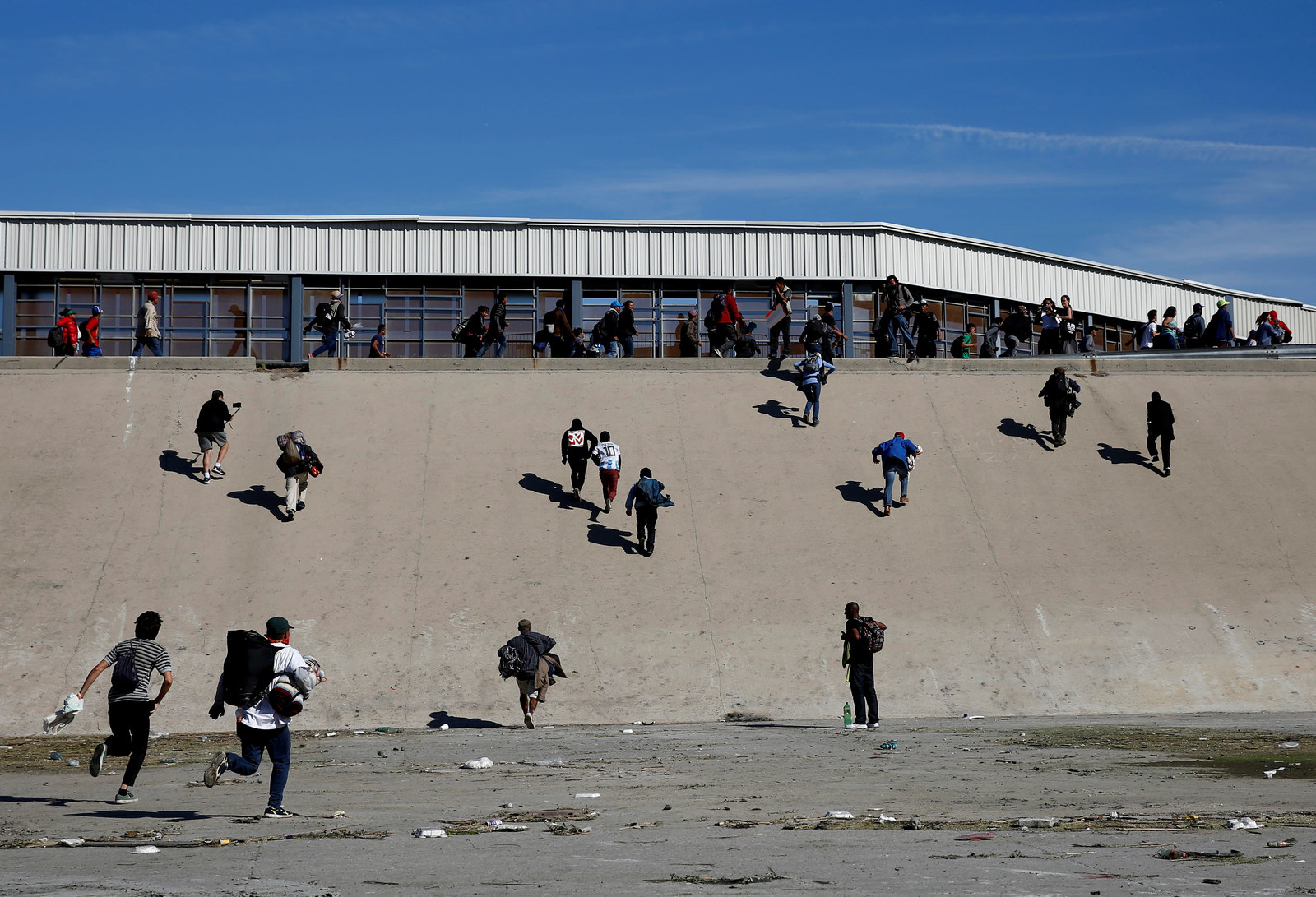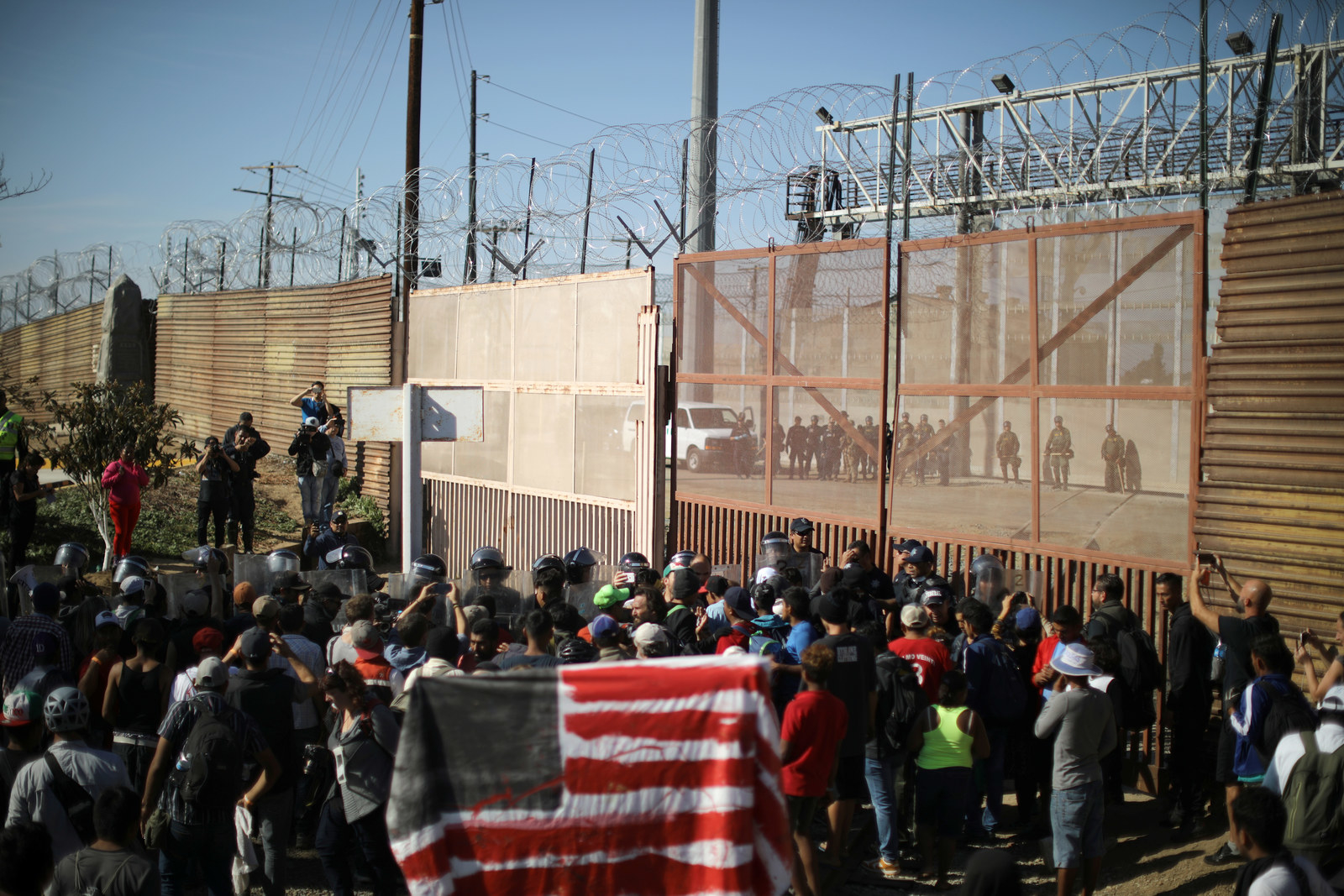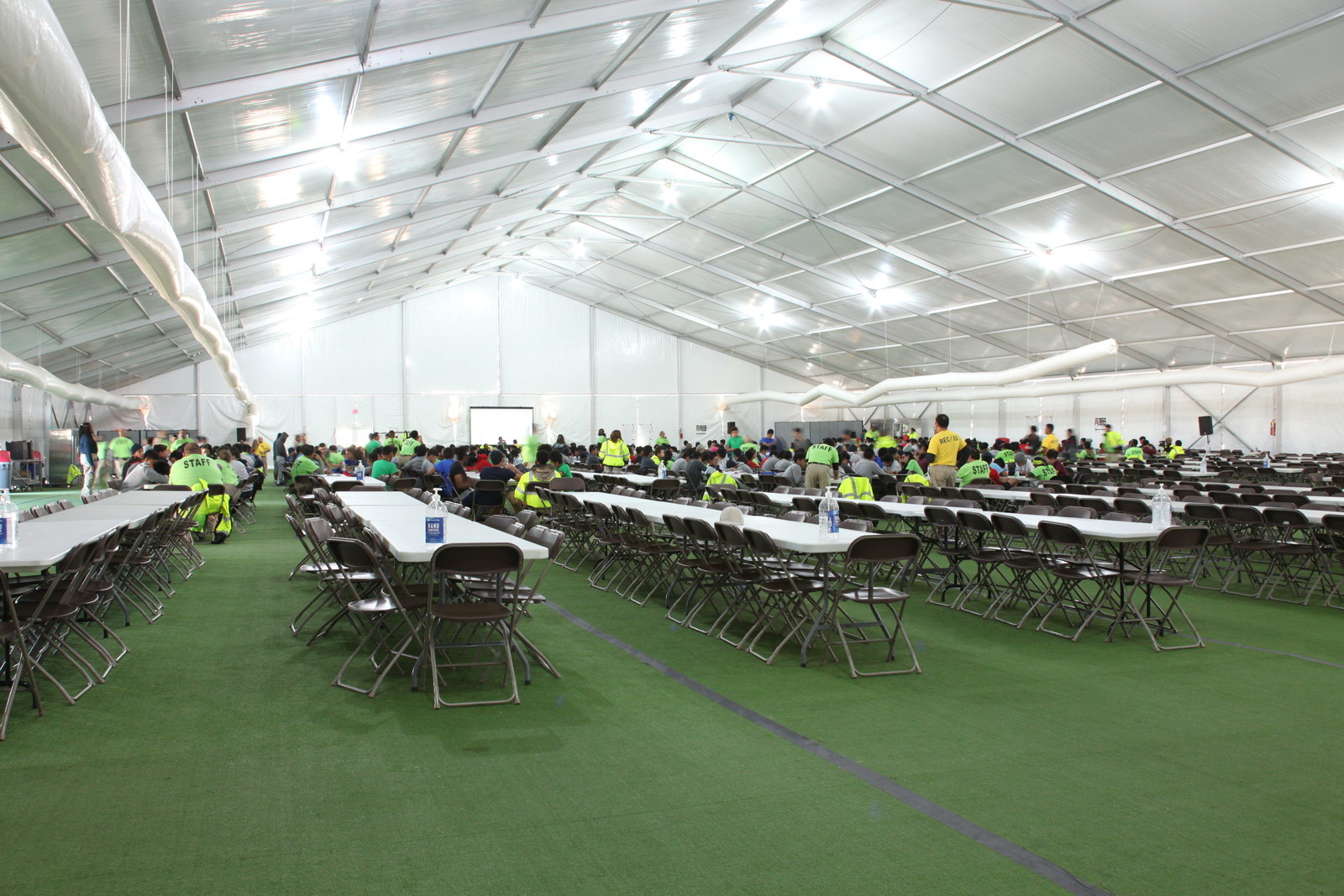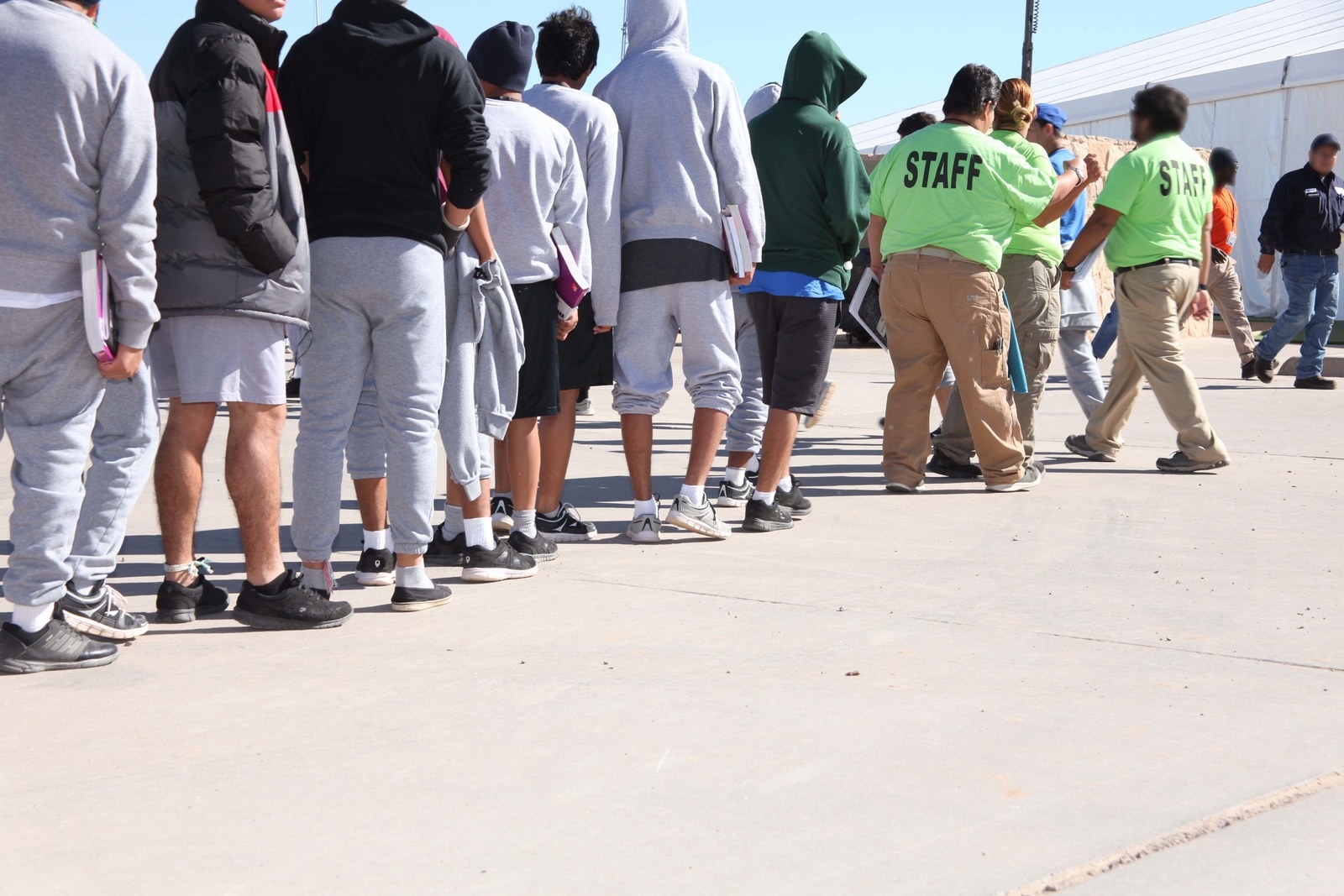Unlike other US courts, immigration judges are employees of the Justice Department whose evaluations are based on guidelines Sessions lays out. In that role, Sessions already has instituted case quotas, restricted the types of cases for which asylum can be granted, and limited when judges can indefinitely suspend certain cases. Advocates believe the Trump administration has made these decisions in order to speed up deportations. His comments on sympathy to immigrants appeared intended to bolster a decision he made recently to limit when asylum can be granted out of fear of domestic or gang violence.
Sessions also told the judges that they should focus on maximum production and urged them to get “imaginative and inventive” with their high caseload. The courts currently have a backlog of hundreds of thousands of deportation cases.
Ashley Tabaddor, an immigration judge in Los Angeles and the president of the National Association of Immigration Judges, which represents the nation’s 350 immigration judges, said Sessions’ speech was notable for its lack of any mention of fairness or due process. “We cannot possibly be put in this bind of being accountable to someone who is so clearly committed to the prosecutorial role,” said Tabaddor.
The union has long called for its separation from the Department of Justice in order to be truly independent of political decision-making.
“Good lawyers, using all of their talents and skill, work every day — like water seeping through an earthen dam — to get around the plain words of the [Immigration and Nationality Act] to advance their clients’ interests. Theirs is not the duty to uphold the integrity of the act. That is our most serious duty,” Sessions said in a speech to 44 newly hired judges who were being trained in Falls Church, Virginia.
He ended his speech by telling the incoming judges that the American people had spoken in laws and “in our elections.”
“They want a safe, secure border and a lawful system of immigration that actually works. Let’s deliver it for them,” Sessions said.
From the beginning of October through the end of June, immigration judges had granted around 22% of asylum cases and denied around 41% of cases. The rest of the cases were closed. The rate is similar to previous fiscal years. Sessions’ decision to limit the types of cases in which asylum should be granted was made in mid-June.
***************************************
https://www.dailymail.co.uk/news/article-6152755/The-U-S-increase-number-immigration-judges-50-percent-BALLOONING-backlog.html

Valerie Bauman reports for The Daily Mail:
Attorney General Jeff Sessions said Monday that he plans to increase the number of immigration judges in the U.S. by 50 percent by the end of Fiscal Year 2018 – part of the administration’s effort to take on a case backlog that has ballooned under the Trump administration’s zero-tolerance policy.
The number of immigration cases on hold in the U.S. has risen 38 percent since Trump took office, with 746,049 pending immigration cases as of July 31, up from 542,411 at the end of January 2017, according to an analysis of government data by the Transactional Records Access Clearinghouse at Syracuse University.
Sessions asserted his authority on Monday during remarks welcoming 44 newly hired immigration judges – the largest class in U.S. history – noting that they must operate under his supervision and perform the duties that he prescribes.
As you take on this critically important role, I hope that you will be imaginative and inventive in order to manage a high-volume caseload,’ he said. ‘I do not apologize for expecting you to perform, at a high level, efficiently and effectively.’
The attorney general said the system for seeking asylum in the U.S. has been ‘abused for years’ and while the judges must respect immigrants’ rights, they should also ‘reject unjustified and sometimes blatantly fake claims.’
Sessions also had harsh words for the attorneys who represent immigrants, describing them as ‘water seeping through an earthen dam,’ who attempt to ‘get around’ immigration laws.
The message follows a series of policy changes that have put increasing pressure on immigration judges to close cases quickly while taking away their authority to prioritize cases based on their own judgment.
‘We’re clearly moving toward a point where there isn’t going to be judicial independence in the immigration courts anymore,’ former immigration Judge Jeffrey S. Chase told DailyMail.com.
U.S. Attorney General Jeff Sessions delivers remarks to the incoming class of immigration judges in Falls Church, Virginia
For example, the Justice Department earlier this year announced a quota system requiring judges to clear at least 700 cases annually in order to be rated as ‘satisfactory’ on their performance evaluations.
Quotas ‘would threaten the integrity and independence of the court and potentially increase the court’s backlog,’ according to the National Association of Immigration Judges, the union representing the judges.
Sessions also issued a decision earlier this year that takes away the authority of immigration judges to administratively close cases, a process that allowed a judge to indefinitely close low-priority cases to make room on the docket for more serious offenses – such as those involving violent criminals and gang members.
From Oct. 1, 2011 through Sept. 30, 2017, 215,285 cases were administratively closed, according to Sessions. Now experts say those cases will be added back to the dockets, further compounding the backlog.
In addition, Sessions issued a legal opinion earlier this year designed to make it impossible for victims of domestic violence and gangs to seek asylum in the U.S. – which some critics say will limit judicial independence.
Legal experts said Monday that Session’s speech was designed to assert his authority over the judges and impress upon them the importance of issuing rulings consistent with his own philosophy.
‘That was an enforcement speech,’ former immigration Judge Paul Wickham Schmidt told DailyMail.com. ‘The whole implication that somehow (people seeking asylum) are bending the law and that there are attorneys trying to go through loopholes is the opposite of the truth … The losers in these asylum cases aren’t simply migrants trying to game the system. They are people facing real dangers when they go home.’
Sessions did not shy away from calling on the new judges to rise to the challenges before them.
‘Let me say this clearly: it is perfectly legitimate, moral, and decent for a nation to have a legal system of immigration and to enforce the system it adopts,’ Sessions said in his prepared remarks. ‘No great and prosperous nation can have both a generous welfare system and open borders. Such a policy is both radical and dangerous.’
Sessions has said that he has introduced a ‘streamlined’ approach for hiring judges – a historically lengthy process – to bring the average hiring time down to 266 days, compared from 742 days in 2017, according to Department of Justice data.
Immigration judges are appointed by the U.S. attorney general. The new additions bring the total number of immigration judges in the U.S. to 397.
***********************************************
There are lots of helpful charts and graphs accompanying Val’s excellent article. Go to the link above to view them, along with the complete article.
Sessions’s claim that we have a “generous welfare system and open borders” is total BS. We don’t have open borders, and never have had. And SEssions and his GOP cronies have worked hard to make our welfare system not very generous at all, particularly when it comes to foreign nationals. It’s a total insult, as well as an arrogant rewriting of history to imply that the Nixon, Ford, Reagan, Bush I, Clinton, Bush II, and Obama Administrations didn’t care about immigration or border enforcement. All of them took their best shot at it, under the circmstances. I should know, as I served in all of those Administrations except for Bush I. Indeed, if anything, for better or worse, and many would say the latter, enforcement during the Obama era was probably more effective than it has been under the “Trump/Sessions gonzo approach.”
Individuals fleeing from the Northern Triangle aren’t coming for welfare. They are coming to save their lives, something that Sessions’s mindless restrictionist philosophy apparently makes it impossible for him to acknowledge. Moreover, individuals have a statutory right to apply for asylum, regardless of the means of entry. Insuring that asylum, withholding of removal, and protection under the Convention Against Torture are propoerly extended to inbdividuals seeking refuge in the US is just as much a part of “enforcing the rule of law” as are removals. Indeed, the consequencers of wrongfully removing an individual entitled to protection are potentially catestropohic.
OK. Now let’s get beyond Sessions’s White Nationalist screed and get some truth about:
- The ethical standards for Immigration Judges;
- The real intent of the Refugee Act of 19809; and
- What being a fair and impartial immigration judge is really about.
Sessions’s Statement Favoring A Party To Immigration Court Proceedings And Showing Disrespect For The Opposing Party & Their Representatives Violates The EOIR Ethical Code By Showing An “Appearance of Bias.”
Let’s remember that under the strange rules governing EOIR and the Immigration Courts within the USDOJ, Attorney General Jeff Sessions can and has taken on the role as a judicial adjudicator in an individual cases, changing results and setting precedent for the BIA and the Immigration Judges.
So, what does the EOIR Code of Judicial Ethics say about judicial conduct?
V. Impartiality (5 C.F.R. § 2635.101(b)(8))
An Immigration Judge shall act impartially and shall not give preferential treatment to any organization or individual when adjudicating the merits of aparticular case. An Immigration Judge should encourage and facilitate pro bono representation. An Immigration Judge may grant procedural priorities to lawyers providing pro bono legal services in accordance with Operating Procedures and Policies Memorandum (OPPM) 08-01.
VI. Appearance of Impropriety (5 C.F.R. § 2635.101(b)(14))
An Immigration Judge shall endeavor to avoid any actions that, in thejudgment of a reasonable person with knowledge of the relevant facts, wouldcreate the appearance that he or she is violating the law or applicable ethical standards.
. . . .
IX. Acting with judicial Temperament and Professionalism
An Immigration Judge should be patient, dignified, and courteous, and should act in a professional manner towards all litigants, witnesses, lawyers and others with whom the Immigration Judge deals in his or her official capacity, and should not, in the performance of official duties, by words or conduct, manifest improper bias or prejudice.
Note: An Immigration Judge should be alert to avoid behavior, including inappropriate demeanor, which may be perceived as biased. The test forappearance of impropriety is whether the conduct would create in the mind of a reasonable person with knowledge of the relevant facts the belief that the Immigration Judge’s ability to carry out his or her responsibilities with integrity, impartiality, and competence is impaired.
Note: An Immigration Judge who manifests bias or prejudice in a proceeding impairs the fairness of the proceeding and brings the immigration process into disrepute. Examples of manifestations of bias or prejudice include but are not limited to epithets; slurs; demeaning nicknames; negative stereotyping; attempted humor based upon stereotypes; threatening, intimidating, or hostile acts; suggestions of connections between race, ethnicity, or nationality and crime; and irrelevant reference to personal characteristics. Moreover, an Immigration Judge must avoid conduct that may reasonably be perceived as prejudiced or biased. Immigration Judges are not precluded from making legitimate reference to any of the above listed factors, or similar factors, when they are relevant to an issue in a proceeding.
Note: An Immigration Judge has the authority to regulate the course ofthe hearing. See 8 C.F.R. §§ 1240.1(c), 1240.9. Nothing herein prohibits theJudge from doing so. It is recognized that at times an Immigration Judgemust be firm and decisive to maintain courtroom control.
Wow. Sure sounds to me like Sessions is in clear violation of each of these!
Let’s get down to “brass tacks” here. Imagine that you are a represented asylum applicant from the Northern Triangle with an upcoming hearing. The morning of your hearing, you read the statement that Jeff Sessions made to the new Immigration Judges.
That afternoon, when you appear at the hearing you find that none other than Jeff Sessions is yo\ur U.S. Immigration Judge. So, do you think that you and your attorney are going to get a “fair and impartial” hearing, including a possible favorable exercise of discretion” on your asylum application, as our Constitution and laws require? Of course not!
But remember, all asylum applicants are appearing before “judges” who are actually employees of Jeff Sessions. Each judge knows that he or she owes career longevity to pleasing Sessions and his minions. Each judge also knows that at any time Sessions can arbitrarily reach down into the system, without explanation or notice, and “certify” any case or decision to himself.
Clearly, after having publicly taken a pro-DHS, pro-enforcement, anti-asylum applicant, anti-private attorney position, Sessions should not ethically have any role whatsoever in the outcome of cases in the Immigration Court System. But, clearly, he does have such a role. A big one!
If any sitting Immigration Judge conducted himself or herself the way Sessions just did, they would be suspended immediately. How does Sessions get away with disregarding judicial ethics in his own system?
The Refugee Act of 1980 Implements Our International Treaty Obligations Under the UN Convention & Protocol Relating To The Status Of Refugees and Is Actually About “Protecting” Those In Danger, Not Finding Ways Of “Rejecting” Their Claims.
Let’s hear from a former legislator who played a key role in developing and enacting the Refugee Act or 1980, former Representative Elizabeth Holtzman (D-NY) who at that time was the Chair of the House Immigration Subcommittee. This is from the letter that Holtzman recently wrote to Secretary Nielsen resigning from the DHS Detention Advisory Committee because of its perversion of the law, particularly the illegal family separation policy engineered by Sessions.
What is so astonishing to me is how much this country has changed since 1980, when I was privileged as chair of the House Immigration Subcommittee to co-author with Senator Ted Kennedy the Refugee Act of 1980. The Act — which was adopted without serious controversy — created a framework for the regular admission of refugees to the U.S. The immediate stimulus for the bill was the huge exodus of boat people leaving Vietnam. Though the memory of the Holocaust played a role, too, particularly the knowledge that the U.S. could have rescued so many people from the hands of the Nazis but did not. The Refugee Act marked our commitment as a nation to welcoming persons fleeing persecution anywhere.
In those days, the U.S. accepted large numbers of refugees — about 750,000 arrived from Vietnam; 600,000 entered from Cuba; and hundreds of thousands of Jews and their relatives came from the Soviet Union. The thought that the U.S. is frightened today by the presence of an additional 2,000 or so children and parents from Central America is laughable and appalling.
In those days, the U.S. also showed world leadership on refugee resettlement. For example, America understood that it bore a special responsibility for the refugees fleeing Vietnam because of its long involvement in the Vietnam War. Obviously, we could not absorb all the refugees, but our government worked hard to get resettlement solutions for all. First, it persuaded the countries neighboring Vietnam to which people fled in small boats not to push those refugees back out to sea, where they would confront pirates, drowning and other terrible dangers. (I know because I participated in speaking to those countries.) Then, the U.S. organized a world conference in Geneva, where countries agreed to accept specific numbers of refugees. The U.S. was able to induce other countries to act because it took the largest share. Our country’s leadership turned the boat people crisis into one of the most successful refugee resettlement programs ever.
Now, in response to the influx of (mostly) women and their children fleeing horrific violence in Central America, the U.S. government can think only of building a wall and unlawfully separating children from their parents — something I call child kidnapping, plain and simple — as a deterrent to keep others from coming to the US. How far we have we fallen.
And how easy it would be to do the right thing. The U.S. needs to start with recognizing that it once again has a special responsibility for a dire situation, this time in the Northern Triangle. We overthrew the democratically elected government in Guatemala, which was replaced by one right-wing government after another, including one that committed genocide against the indigenous population. In Honduras and El Salvador, we similarly propped up right-wing governments that did nothing for their people, leaving them without effective governance in place. The fact that gangs have been able to terrorize the population with impunity is a result.
More must be done as well. We should reinstate the Central American Minors Refugee/Parole Program, established under President Obama and cancelled by the Trump Administration, whereby people could apply in their home countries for admission as refugees to the U.S. without facing the perils of the overland trip. Second, we should try to get Canada and other countries in South America to accept refugees from the Northern Triangle countries, reducing the burden on us. To do this, we would have to agree to take a substantial number of refugees from the Northern Triangle countries as well. And then we should work to improve the governance in these countries, perhaps by involving the United Nations and nearby countries, such as Costa Rica.
Unfortunately, the chance of any such enlightened response toward refugees from the Northern Triangle seems remote. These countries probably fall into Trump’s stated “shithole” category. Plainly, the hostile attitude toward the refugees persists. For example, 463 parents may have been deported without their children. Apparently DHS Secretary Kirstjen Nielsen feels no responsibility for reuniting those with their parents, instead making the flimsy excuse that the parents wanted to leave them behind. While possibly true in a small number of instances, given the fact that many of the parents do not speak English, or even Spanish, but their indigenous language, it is more likely that a significant number of the parents had no idea of what was happening or how to get their children back. They may even have been coerced into leaving. In any case, Nielsen has a very poor record of truth-telling. On June 17, she insisted that “We do not have a policy of separating families at the border. Period.”
And the racist, contemptuous attitude of the Administration keeps showing. Just recently, before a conservative audience, Attorney General Jeff Sessions made a joke — a joke! — about separating children from their parents. (He also briefly joined in a chant of “Lock her up!”)
Most Americans, fortunately,
have found the separation policy abhorrent. Those of us who do, need to press the Administration to find a more humane and more comprehensive solution, like our country has done in the past. But if the Administration continues the enforced separation policy, I hope that the courts will enforce their decisions,
which have required reunification, by holding the Secretary and others in contempt if necessary. Congress should be called on to act by holding hearings and adopting censure resolutions. None of us can sit idly by when our government stoops to such racist, malign behavior.
Yes, with responsible leadership, it would be relatively easy to do the right thing here. But, it’s not going to happen with the “wrong people” like Donald Trump, Stephen Miller, Jeff Sessions, and Kristjen Nielsen in charge.
The real intent of the Refugee Act of 1980 was to give America the tools to take a leadership role in protecting individuals, particularly those flowing from situations we helped cause like the mess in the Northern Triangle. I’m sure that most of those involved in the bipartisan effort would be shocked by the overtly racist, restrictionist views being pawned off by Sessions as “following the law.” “I call BS” on Session’s perversion of protection laws.
Undoubtedly, cases like Matter of A-R-C-G-, incorrectly overruled by Sessions, actually substantially understated the case for protecting domestic violence victims. There is little doubt in my mind that under a proper interpretation “women in El Salvador” (or Guatemala or Honduras, or many other countries) satisfy the stated criteria for a “particular social group.”
Being a “woman in El Salvador” clearly is :
- Immutable or fundamental to identity;
- Particularized; and
- Socially distinct.
Moreover, there is no legitimate doubt that the status of being a “woman in El Salvador” is often “at least one central reason” for the persecution. Nor is there any doubt that the Governments in the Northern Triangle are unwilling and unable to offer a reasonable level of protection to women abused because of class membership, Sessions’s largely fictional account of country conditions notwithstanding.
At some point, whether or not in my lifetime, some integrity will be re-injected into the legal definition by recognizing the obvious. It might come from Congress, a more qualified Executive, or the Courts. But, it will eventually come. The lack of recognition for women refugees, who perhaps make up a majority of the world’s refugees, is a symptom of the “old white guys” like Sessions who have controlled the system. But, that’s also likely to change in the future.
My esteemed colleague, retired U.S. Immigraton Judge Jeffrey S. Chase said it best:
“Sessions is characterizing decisions he personally disagrees with as being based on sympathy alone,” he said, “when in fact, those decisions were driven by sympathy but based on solid legal reasoning.”
The Proper Role Of a Good Immigration Judge Involves Sympathetic Understanding Of The Plight Of Refugees, What They Have Suffered, & The Systemic Burdens They Face in Presenting Claims.
Let’s see what some real judges who have had a role in the actually fairly adjudicating asylum claims have to say about the qualities of judging.
Here’s one of my favorite quotes from the late Seventh Circuit Judge Terence T. Evans in Guchshenkov v. Ashcroft, 366 F.3d 554 (7th Cir. 2004) (Evans, J., concurring) that sums up the essence of being a good Immigration Judge:
Because 100 percent of asylum petitioners want to stay in this country, but less than 100 percent are entitled to asylum, an immigration judge must be alert to the fact that some petitioners will embellish their claims to increase their chances of success. On the other hand, an immigration judge must be sensitive to the suffering and fears of petitioners who are genuinely entitled to asylum in this country. A healthy balance of sympathy and skepticism is a job requirement for a good immigration judge. Attaining that balance is what makes the job of an immigration judge, in my view, excruciatingly difficult.
Or, check out this heartfelt statement from my former colleague Judge Thomas Snow, one of “Arlington’s Finest,” (who also, not incidentally, had served as the Acting Chief Immigration Judge and Acting Director of EOIR, as well as being a long-time Senior Executive in the USDOJ) in USA Today:
Immigration judges make these decisions alone. Many are made following distraught or shame-filled testimony covering almost unimaginable acts of inhumanity. And we make them several times a day, day after day, year after year.
We take every decision we make very seriously. We do our best to be fair to every person who comes before us. We judge each case on its own merits, no matter how many times we’ve seen similar fact patterns before.
We are not policymakers. We are not legislators. We are judges. Although we are employees of the U.S. Department of Justice who act under the delegated authority of the attorney general, no one tells us how to decide a case. I have been an immigration judge for more than 11 years, and nobody has ever tried to influence a single one of my thousands of decisions
And finally, because we are judges, we do our best to follow the law and apply it impartially to the people who appear before us. I know I do so, even when it breaks my heart.
Here’s a “pithier” one from my friend and colleague Judge Dana Leigh Marks, former President of the National Association of Immigration Judges (who also was the “winning attorney” representing the plaintiff in INS v. Cardoza-Fonseca, 480 U.S. 421 (1987)) — I was on the “losing” INS side that day):
[I]mmigration judges often feel asylum hearings are “like holding death penalty cases in traffic court.”
Finally, here’s my take on being an Immigration Judge after 45 years in the field, including stints at the BIA, the “Legacy INS,” private practice, and academics:
From my perspective, as an Immigration Judge I was half scholar, half performing artist. An Immigration Judge is alwayson public display, particularly in this “age of the Internet.” His or her words, actions, attitudes, and even body language, send powerful messages, positive or negative, about our court system and our national values. Perhaps not surprisingly, the majority of those who fail at the job do so because they do not recognize and master the “performing artist” aspect, rather than from a lack of pertinent legal knowledge.
Compare Sessions’s one-sided, biased outlook with the statements of those of us who have “walked the walk and talked the talk” — who have had to listen to the horrible stories, judge credibility, look at whether protection can legally be extended, and, on some occasions, look folks in the eye and tell them we have no choice but to send them back into situations where they clearly face death or danger.
Sympathetic understanding of refugees and the protection purposes of refugee, asylum, and CAT laws are absolutely essential to fair adjudication of asylum and other claims for relief under the Immigration Laws. And, clearly, under the UNHCR guidance, if one is going to err, it must be on the side of protection rather than rejection.
That’s why Jeff Sessions, a cruel, biased, and ignorant individual, lacking human understanding, sympathy, a sense of fundamental fairness, a commitment to Due Process, and genuine knowledge of the history and purposes of asylum laws has no business whatsoever being involved in immigration adjudication, let alone “heading” what is supposed to be a fair and impartial court system dedicated to “guaranteeing fairness and Due Process for all.”
Senator Elizabeth Warren tried to tell her colleagues and the rest of America the truth about Jeff Sessions and the horrible mistake they were making in putting such a famously unqualified man in charge of our Department of Justice. But, they wouldn’t listen. Now, refugees, families, and children, among his many victims, are paying the price.
Sessions closes with a final lie: that the American people spoke in the election in favor his White Nationalist policies. Whether Sessions acknowledges it or not, Donald Trump is a minority President. Millions more voted for Hillary Clinton and other candidates than they did for Trump.
Almost every legitimate poll shows that most Americans favor a more moderate immigration policy, one that admits refugees, promotes an orderly but generous legal immigration system, takes care of Dreamers, and controls the borders in a humane fashion as opposed to the extreme xenophobic restrictionist measures pimped by Sessions, Trump, Steven Miller, and the GOP far right. In particular, the separation of children, Sessions’s unlawful “brainchild,” has been immensely (and rightfully) unpopular.
Jeff Sessions has never spoken for the majority of Americans on immigration or almost anything else. Don’t let him get away with his noxious plans to destroy our justice system! Whether you are an Immigration Judge, a Government employee, or a private citizen, we all have an obligation to stand up to his disingenuous bullying and intentionally false, xenophobic, racially-motivated, unethical, scofflaw narrative.
PWS
09-11-18











